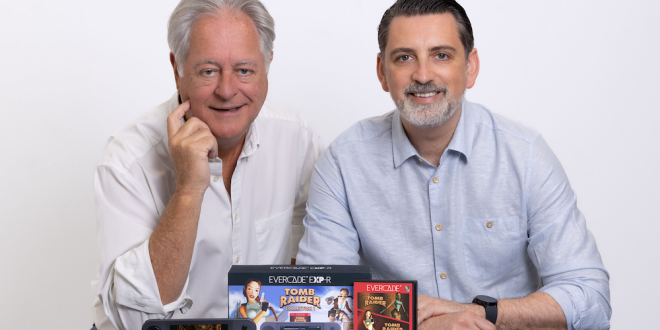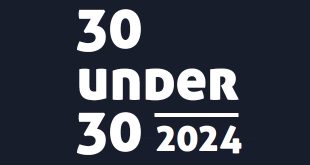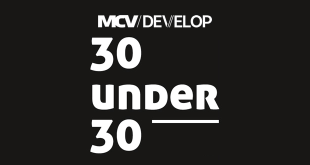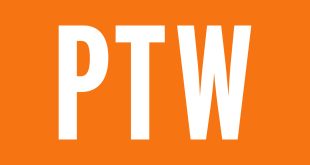The Evercade platform, augmented by the Game Boy-inspired Super Pocket last year, is about to enjoy a refresh to its console and handheld hardware ahead of an arcade-style system, the Evercade Alpha, joining the line-up at the end of the year.
The revised systems, the EXP-R and VS-R, will be bundled with the Tomb Raider Collection, a sign that the retro platform is moving into a new era of gaming.
It’s not just the hardware that’s changing. Dominic Wheatley, who launched the original Tomb Raider back in 1996, is just getting settled into his new role as Blaze’s chairman, alongside CEO Andrew Byatt, both of whom were kind enough to speak to us about how they joined forces and the plans being enacted that will take the Evercade brand into the future.
MCV: Dominic, how did you come to join Blaze ?

Dominic Wheatley: A couple of advisors had been talking to Andrew and Dave Pain, who’s one the shareholders, and sort of said ‘Maybe you should talk to Dominic because he’s also done this kind of thing.’ So they basically reached out to me and said, ‘Hey, let’s have lunch’. Of course, I looked into Evercade and discovered what they’re up to and I just thought it was brilliant. …One thing led to another and they said, ‘Hey, would you be interested?’ Now, of course, I’ve still got my Catalis hat and I’ve taken a little bit of a backseat there, but given that my work was done to some extent, I had some time on my hands and said, ‘Yeah, why not!’ So that’s how it happened. It was just an introduction, really.
Andrew Byatt: From our perspective, Dominic is someone who is very well known in the industry and has an amazing pedigree, who has loads of experience in all sorts of areas of our business, whether it’s licensing, whether it’s marketing, or whether it’s in helping us with the finance side. So it seemed to be a great opportunity and it was amazing to get him on board and as part of Blaze.
MCV: Does the appointment represent a change in strategy?
Andrew: Dominic’s not here to change the game in that sense. More it’s helping us step up in various areas and helping us with contacts and distribution arrangements and agreements. We’ve done pretty well from the get-go to come up with a concept in terms of why Evercade exists and that isn’t changing.
MCV: Why does it exist?
Dominic: What these guys had done was go back to the drawing board and produced three hardware types. One is of course a classic console (Evercade VS) you stick under the telly and you put your cartridge in and off it goes. The handheld (Evercade EXP), which is my personal favourite, has got great form factor, and again, cartridge in the back and off you go. Then finally the pocket version, which is just a small screen that you can literally put in the back pocket of your jeans. And the same games work on all three. The idea is terrific.

Andrew: For me, it was always about recreating that original gaming experience. That’s partially a physical thing. So you’ve got manuals and you’ve got cartridges – and you can blow on those cartridges before you put them in – so it’s not just like a download and then you play the game, which does deliver nostalgia, of course, but for us it was all about what it was like.
On top of the nostalgia thing it’s about discovery, so people that perhaps weren’t there get to discover these games and I think that is what attracted Dominic to the business – why it mattered, why it worked, recreating that experience and delivering to people that weren’t there.
Dominic: I think there are two aspects. One is that, of course, you have people of a certain generation remember these early games and love to be able to play them again. Then you’ve got a newer audience who just want to be able to play retro games in a way that is quick and easy. A lot of people find it enormously complicated to get into big games today. They just don’t have the time, which is why mobile has been so successful.
Don’t forget that in the vintage era of video games your game had to be really fun. It wasn’t played because it was beautiful. It wasn’t played because it had amazing music. If it wasn’t interesting and fun, the game would fail.
Andrew: Evercade was born in 2020 when we released the original handheld and the first ten cartridges. We signed all the licences, we’d invested in it as a business and then we held our breaths to some extent to see whether it worked. Over time, we’ve found that actually people do love collecting for this product and playing this product. We have regular releases that people can follow and they can really engage with the community, so building that community site has been really important for us. Dominic is sort of a leg up, to help us get to the next level.
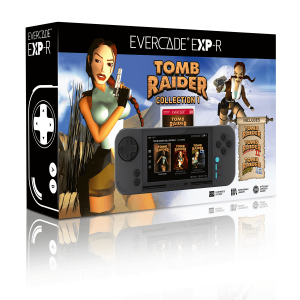
MCV: What does the next level look like?
Dominic: One of my roles is to help us get distribution – particularly in North America, where I lived for many years – and also, in due course, to help raise the funds to get to the next step. Those are my main missions. Licensing too to some extent, if I can be helpful, but really I have to say that Andrew and his team have been brilliant there. There are 500 games that he’s licensed so far and every quarter we come up with another couple of cartridges. Most have ten or more games on them and in the case of Tomb Raider it’s just the three, and at the moment we’re looking at Playstation 1, PC, and that sort of thing. There will be a time, in three or four years, when the hardware will be upgraded, the chips will be a bit cheaper, and they will be able to do PlayStation 3 games and Xbox games and so you’ll march in step with with the industry as it gets older.
Andrew: We’ve got different hardware, but essentially it’s the same generation of cartridges, so whether you have the original handheld, the EXP, the new EXP-R, or the Super Pocket, it’s all completely consistent so you can play all those games. And as Dominic says, the 32-bit/64-bit era is where we top out on hardware at the moment.
MCV: The Super Pocket was an interesting addition, but why did you release it under a new brand – Hyper Mega Tech?
Andrew: The Super Pocket is there as a kind of entry point. It’s got some really amazing pre-loaded games, so whether you buy it as a standalone experience or buy any more carts is up to you. That goes back to the point about why we’re different: Mini consoles (PlayStation Classic, A500 Mini, etc) are really amazing products with great software, but the experience ends after however many days you get out of them in terms of entertainment. With the Super Pocket, we didn’t want to make products that ended on day three. That you’d play for a bit and then stick in the drawer. We wanted to make something that had real value as a console that went forward as something that you can play retro games on. Equally, we also recognised that people don’t have huge amounts of money right now. We didn’t want to make something super expensive. We were trying to find that value piece for people.
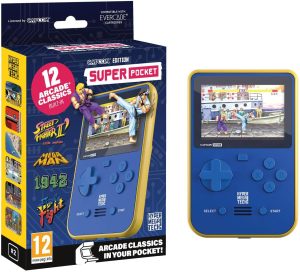
MCV: Does that attention to value extend to the games?
Andrew: The Tomb Raider collection has three titles on it. Atari Collection 1 has 20 titles, Another arcade collection has ten, another has six, so it’s a real mix. The pricing is consistent, so we’ve got two price bands for cartridges. The first one – which is for 99% of cartridges – is $20, and the other price point is the Tomb Raider price point. That’s actually because it’s a higher capacity chip, not so much because it’s Tomb Raider. As we release newer stuff we will have higher capacity chips, which we will need to deliver more content on those cartridges. But all the initial 50-odd cartridges are all the same price, whether people get two games on them or whether they get 20. A developer might just have two amazing titles, and that’s what we sign. Everyone seems to accept that pricing.
Value is really important to us, because classic games are really expensive to collect. If you want to collect those original discs and original cartridges, it’s an expensive thing to do, and this is like an alternative way of doing it. You still build a collection, you’ve still got lots of choice, but you’re not having to spend so much money which is good for some people.
MCV: An interesting release for Evercade was OutOfTheBit’s Full Void. How did it perform?
Andrew: Full Void did really well. People really enjoyed it. It’s a beautiful game, which does help, but that was the first time we’ve done a single game on a cartridge. And it made sense to do that because at the time it was a brand new release on all platforms. We’ve just kind of got treated as another platform.
Of the 500-odd games that we’ve released, around 80 of them are “indie retro”. What I mean is they’ve been recently created in a retro style, whether they be for original consoles, or they might be for modern hardware which we ported like Full Void. So 80-odd games. It’s quite a lot – 13 of our cartridges. So yeah, we do talk to people about this and we do help with their visibility and that is the same for Full Void. We do help them and that’s part of their strategy; to get it on multiple platforms and and we’re one of those platforms in the retro space
I think as well, on the organic PR side, it’s quite difficult if you have a small title in terms of it being a new IP or something from a small developer. If they send a Steam code to a journalist and say ‘Can you review this?’ that guy possibly got 20 codes that day. One of the advantages we had I guess is that we can send a physical product with a nice manual. It sets us apart and it helps promote the game.
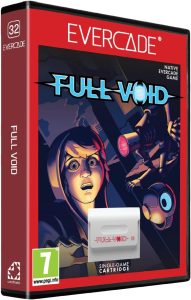
MCV: And now you wish to take Evercade’s physical presence to the next level?
Dominic: I think one of the key things that we’re trying to do now is get retail exposure. A lot of Evercade games and hardware has been sold though sites like Amazon, but not so much of it is being stacked on the shelves in stores. We’re missing a lot of footfall. We’re missing a lot of impulse purchases. So the goal really this year is to partner up with someone, get some exposure and prove the model. Then next year, when the retailers are starting to think about what they’re going to do for Christmas ‘25, we can get in there early.
It’s the razor-razorblade model: we’re going to get the hardware in the home and then sell the games and build an ecosystem around that. We haven’t quite got there yet. It’s amazing [Andrew and the team] have done so well, to be honest with you. To me it shows that there is a demand for this kind of product, and the fact they’ve sold a million cartridges is pretty amazing, considering that it’s obviously a small company, without vast amounts of money and without an obvious retail presence.
Andrew: As a brand we were born in the middle of COVID and that set a precedent to some extent as to our ability in the first two years to get on shelves. The Super Pocket is a little bit of a reaction to that. It’s a product honed to fit better on the shelf. It’s a kind of pickup item, because with any kind of console brand it’s all about install base. You need to get the hardware in people’s hands and you have to do that in various ways.
It’s a bit cheesy, but we sort of compare ourselves to albums and vinyl and saying, actually, there’s loads of value here on the physical side. There might be some “hits” on that cartridge, and then there’s a lot of “b-sides” from that developer that maybe you don’t know and suddenly what you find is when you spend a bit of time with those carts, and they’re curated in that kind of way that you find that some of those b-sides are actually your favourite titles that you never would have played otherwise. But if you give them love, affection and context, then they really have value and I think that’s what we’re doing in classic games.
Dominic: The key thing here is that this is for the long term. We’re trying to build a platform for the future, so that it’s in step with what becomes retro. We will try to revise the hardware as we go. But I think it’s got a long term future.
What we want is to be on the right types of shelves for the long term, because once you’ve got the hardware into homes, the cadence of software releases and pick-up can be more measured, particularly as a lot will be satisfied online.
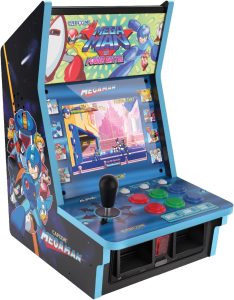
MCV: The recently revealed Evercade Alpha is more recognisable as a retro arcade machine. What was the thinking behind that?
Andrew: It’s another way to play these collections. It’s a higher price point product and it’s also a big market, especially in America with its arcade culture. So, whereas some people want to play on a handheld, some people want to play on the TV via a controller, some people want to play all these games with original arcade controls.
MCV: Dominic, you launched Tomb Raider all those years ago. Was the prospect of launching the game again on Evercade a factor behind you joining Blaze?
Dominic: It wasn’t my idea, but it certainly got my endorsement and it’s this serendipity that Lara is now back where she started.
Going forward, we will be doing more packs like the Tomb Raider pack. It could be Bond, Star Wars, whatever. Branding hardware with examples of what games that can play on it and actually come with the box is a tried and tested marketing device. Software sells hardware. I think it’s great fun and I think retail has been grateful to have something that they can actually sell. This is a way for retailers to get back in the game.

 MCV/DEVELOP News, events, research and jobs from the games industry
MCV/DEVELOP News, events, research and jobs from the games industry
